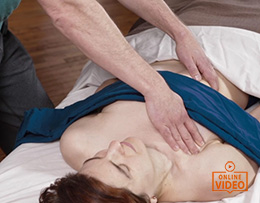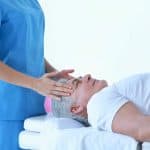The Hara, or energetic center of the body, is a crucial part of the practice of shiatsu when it comes to both assessment of a client as well as the center of focus for the practitioner. It is considered the center of gravity (of the physical body) in Asian cultures where, for centuries, the people have spent much of their lives close to the ground, sitting not in chairs as in western cultures, but on floor mats. It is considered the place from which all movement flows and, in shiatsu, it is considered a place of communication between client and practitioner.
Location of the Hara
The Hara is located on the front or anterior portion of the body. It lies just below the inferior portion of the rib cage, forming a kind of circular area reaching down to the pubic crest and sideways about two hand widths on either side of the navel. Just below the navel, about three finger widths, is the Dan Tien, considered the center of the Hara and the energetic focus point for the practitioner.
With shiatsu and many other type of massage or bodywork it is important for the practitioner to get out of his or her head, away from the intellectualism so prevalent in the west, and bring the focus down instead to the energetic center of the Hara.
Elements of the Hara
The Hara is divided into sections, each corresponding with the body’s meridians, or energy channels, which in turn correspond to various body organs. Several of the areas can be located like sections of a clock face. For example, at the number one position, directly under the xiphoid process, at 12:00 on the clock is the area for the Heart.1:00 is the Stomach and 2:00 is the Triple Heater, 3:00 and 9:00 represent the Lungs, 10:00 is the Liver and 11:00 is the Gall Bladder. The spleen is located around the navel and beneath that area in a “U” shape lies the Kidney, reaching around and up both sides. Below the Kidney is the Urinary Bladder, also in a “U” shape, almost completely up and around the Kidney area. As with the Lung areas, there are two each of the Small Intestine and the Large Intestine. The Large Intestine covers areas 4:00 to 5:00 on our clock, as well as 7:00 to 8:00. The Small intestine crosses over the Large approximately in the center and reaches over and through the Urinary Bladder and the Kidney sections.
Please note that these are NOT locations of the actual organs in the body, but locations of energetic centers of the organs for means of assessment.
Assessing By Touch – Kyo and Jitsu
During the intake portion of a bodywork session, questions have been asked and visual observations made. Once the client is lying supine on the massage table or floor mat, and the practitioner has centered assessing by touch, palpation can begin. Using the soft tips of the fingers the practitioner gently presses the various sections of the abdomen. The traditional order of palpation beings at the Heart and then moves to the areas of Gall Bladder, Liver and Lung. The hands move back to the Heart, then Stomach, Triple Heater and Lung. The Heart Protector (aka Pericardium) is next, followed by Kidney, Urinary Bladder, the Left Lung, Left Small Intestine, Right Lung and Right Small Intestine. What you are trying to get is a feeling of softness or hardness. Is the body pushing back or letting you sink in?
Two terms that will be important for the assessment are kyo and jitsu, or a feeling of empty (kyo) or full (jitsu) in relation to a client’s ki (aka qi or chi), an energetic level within the body. This can easily be related to the concept of yin and yang.
Using the soft tips of the fingers, the practitioner palpates around the client’s Hara, getting a sense of that various organ energies. Some areas may feel like they are pushing out – this would be jitsu, indicating an excess or even a blockage of energy. Some areas may feel as if they are taking you in – this would be kyo and indicative of a depletion or lack of energy. There will never be a Hara that is all kyo or all jitsu. An area of one will always have a corresponding area of the other as the body tries to balance itself out.
In palpating the Hara, you will also listen with your hands for areas that may have a pulsing sensation, temperature variations, tension or pain. Each of these has meaning, not so much on their own, but in relation to each other. Listen well and you will know which areas of the body, which corresponding energetic pathways, need work
Your job as a bodywork practitioner is to help even out the energy, clear blockages and assist the body in having a smooth flow in the meridian channels.
To learn how to use the Hara for assessment purposes it is usually best to find a teacher who can lead you through it until you get a good understanding for the feel of kyo and jitsu. The body often speaks to the practitioner in subtle ways and this takes a lot of practice on a lot of bodies. In time it can be used as an effective tool in your bodywork practice.
Recommended Study:
















